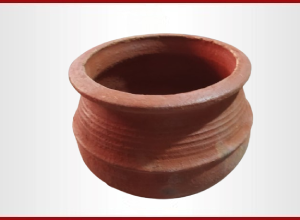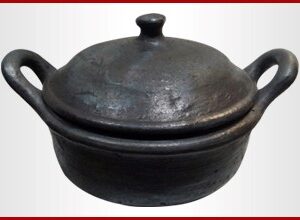





VISIT OUR STUDIO
Our Company
Panja Buthas are Air, Water, Land, Sky and Fire, out of this soil has the power to produce, earth gives us food from cultivation. Likewise earthen pots also have many health benefits while using for cooking, storing drinking water will regenerate energy.
General Questions
- Alkaline food is the best for our body but in today’s fast world we prefer more acidic food which produces toxins that causes diseases.
- Since Clay is alkaline in nature and when food is cooked, it neutralizes the PH balance of food and hence acts as natural detox.
- Cooking in Clay pot is same as the process of steaming and hence retains the nutrition in the food.
- No extra oil is needed for cooking which helps to maintain cholesterol levels.
- Reheating the food always leads to loss of nutrition but if you cook in clay pot it retains the temperature for a longer time and no worries for reheating.
- Clay pot is porous and heat circulates through the pot which retains the aroma and nutrition of food.
- The food is cooked slowly and completely and no need to add extra fat or oil.
- You can cook almost anything in it and is even suitable for microwave.
- The Clay pot retains temperature for a longer time as compared to steel utensils
- Last but not least, it makes the food tasty comparing to cooking in other utensils.
- Many scientific Researches have proven that clay pots are the best and most economical.
- Cooking pots brings a unique taste to food.
Seasoning clay pots is essential to ensure their longevity and enhance the flavors of your dishes.
Here’s a basic method for seasoning clay pots:
1.Wash the Pot: Before seasoning, wash the clay pot thoroughly with warm water and a mild detergent. Rinse it well to remove any soap residue.
2.Soak the Pot: Submerge the clay pot in water for at least 2-3 hours or overnight. This allows the pores of the clay to absorb water, reducing the likelihood of cracking during seasoning.
3.Oil Coating: Once the pot is soaked, coat both the interior and exterior surfaces lightly with cooking oil, such as vegetable oil or olive oil. Use a paper towel or cloth to apply the oil evenly.
4.Bake in Oven: Place the oiled clay pot in a cold oven. Then, set the temperature to around 300-350°F (150-175°C) and let it bake for 1-2 hours. This process helps the oil penetrate the clay, creating a protective layer and preventing food from sticking.
5.Cool and Repeat: Allow the pot to cool completely in the oven before removing it. You can repeat the oiling and baking process a couple of times to build up a stronger seasoning layer.
6.Care and Maintenance: After seasoning, always hand wash your clay pot with warm water and avoid using harsh detergents or abrasive scrubbers, as they can strip away the seasoning. Allow the pot to air dry completely before storing it.
With proper seasoning and care, your clay pot will develop a natural non-stick surface and impart delicious flavors to your meals for years to come.
Note: Avoid adding oil to a heated pot immediately after 5-6 times of cooking. After that you can use the oil directly.
These clay pots have minute pores holes and when we store water in these pots tiny pores holes oozes out water. Those water gets evaporated absorbing heat from water stored inside mud pot. This process is happening continuously and the end result is cool water inside mud pot.
ADVANTAGE
Storing water in mud pot is an old age tradition and also the best and natural alternative for refrigerated water. Many prefer to drink cold water from fridge to quench their thirst immediately after returning home from hot sun but it leads to cold, cough,sometimes even fever especially in summer it affects digestion by freeing oil stuffs we eat and Doctors now found having too cool water may lead to cancer..! . But water stored in mud pot acts gentle on throat and good for health.
Storing water in clay pots is a practice that has been valued across various cultures for centuries due to its numerous benefits. Here are some of the key advantages of using clay pots for water storage:
1. Natural Cooling
Clay pots provide a unique cooling effect on the water stored within them. The porous nature of clay allows a small amount of water to seep to the outer surface where it evaporates, reducing the temperature of the water inside the pot. This process, known as evaporative cooling, can keep the water pleasantly cool even during hot weather without the need for refrigeration.
2. Improved Taste
Water stored in clay pots can have a refreshing and natural taste. Unlike plastic or metal containers, clay does not impart any undesirable flavors to the water. Many people find that water from a clay pot tastes fresher and more earthy, which can be a pleasant change from chemically treated or metallic tasting tap water.
3. Alkaline Environment
Clay is alkaline in nature, and when water is stored in a clay pot, the clay interacts with the water and can increase its pH slightly. This slight increase in alkalinity can help neutralize acidity in the body and contribute to overall health and well-being.
4. Health Benefits
Clay pots are made from natural materials and do not contain chemicals found in plastic containers such as BPA (Bisphenol A) and phthalates, which can leach into water and pose health risks. Additionally, the micro-nutrients from the clay itself, such as calcium, iron, magnesium, and sulfur, can leach into the water, adding to its health benefits.
5. Environmentally Friendly
Using clay pots for storing water is an environmentally friendly choice. Clay pots are sustainable and biodegradable, reducing the reliance on plastic bottles which contribute to pollution and waste. Additionally, the manufacturing process for clay pots generally has a lower carbon footprint compared to that of plastic containers.
6. Cost-Effective
Clay pots are generally inexpensive and widely available in many parts of the world, making them an accessible option for many people looking to store water in a healthier and more natural way.
7. Preserves Water Quality
Clay has a number of inherent properties that can help preserve water quality. The slightly porous nature of unglazed clay not only helps cool the water but can also filter out some impurities. Additionally, the storage environment in a clay pot can help keep the water free from many pathogens that thrive in warmer environments.
8. Aesthetic Appeal
Clay pots often have a traditional or rustic appearance, adding an aesthetic element to households. They can be both a functional and decorative addition to a kitchen or dining area.
Overall, storing water in clay pots is not just a traditional practice but also a functional choice that offers numerous health, environmental, and economic benefits. It is a simple yet effective way to enhance the quality of drinking water.
OUR BEST SELLER
- ALL PRODUCTS
- MODERN & TRADITIONAL COOK WARES
- DECORATIVE POTS
- WATER CONTAINER POTS
FREE SHIPPING
For all order
DELIVERY ON TIME
Defination and measurement
SECURE PAYMENT
100% Secure Payment
DEALS OF THE DAY
Jug
Organic Face Scrub
Curd Pot
Defuser




































































